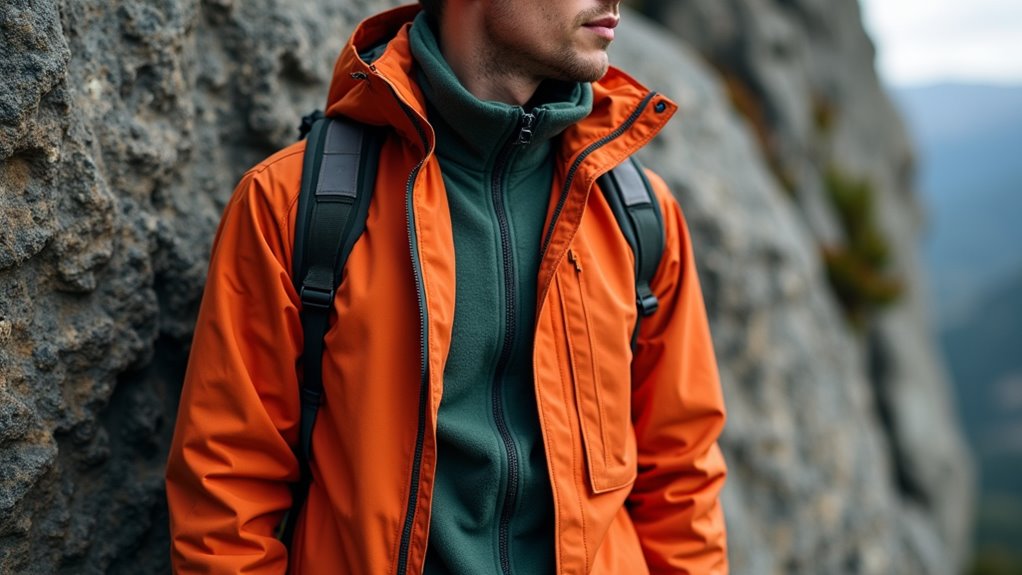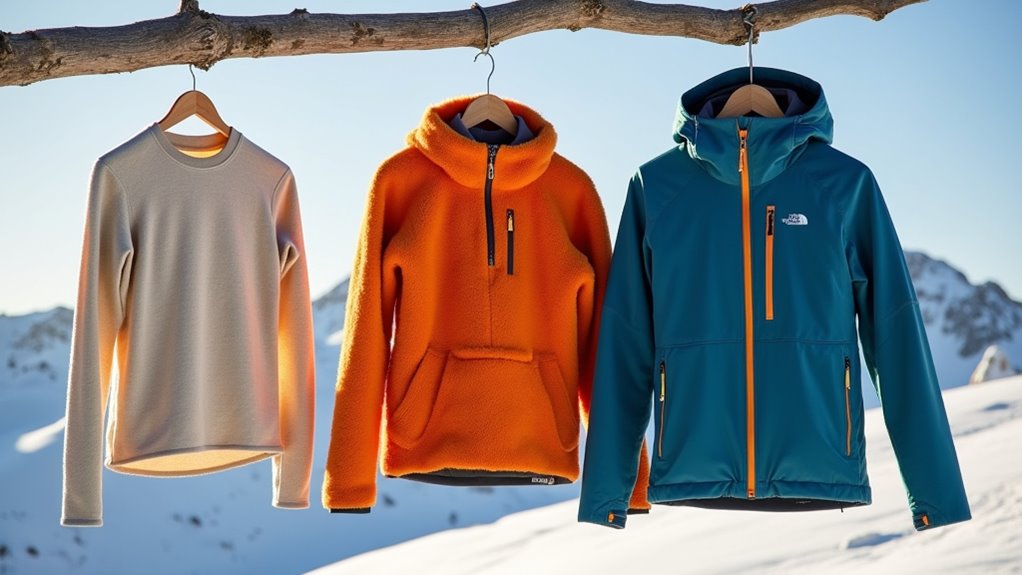Physical Address
304 North Cardinal St.
Dorchester Center, MA 02124
Physical Address
304 North Cardinal St.
Dorchester Center, MA 02124

Get the three-layer hiking system right or risk hypothermia—most hikers make critical mistakes that could prove deadly.
When you’re planning a winter hike, your clothing choices can mean the difference between an enjoyable adventure and a dangerous situation. You’ve probably heard about the three-layer system, but understanding how each layer works together isn’t as straightforward as it seems. The wrong combination of base layer, insulation, and shell can leave you soaked in sweat or shivering uncontrollably. There’s a specific science to layering that most hikers get wrong, and it starts with choosing the right foundation.

When you’re heading into cold, unpredictable mountain weather, the three-layer clothing system becomes your best defense against hypothermia and discomfort. This proven approach breaks down your clothing into three distinct layers, each serving a specific purpose.
The base layer sits against your skin, wicking moisture away to keep you dry. Your mid-layer provides insulation, trapping warm air while allowing moisture to escape. The outer shell layer protects you from wind, rain, and snow while letting perspiration breathe through.
What makes this system brilliant is its adaptability. You can add or remove layers as conditions change throughout your hike. Too warm climbing uphill? Strip off the mid-layer. Weather turning nasty? Add your shell. This flexibility keeps you comfortable and safe.
Since your base layer touches your skin directly, it becomes the foundation of your entire layering system. Your skin constantly produces moisture through perspiration, and if that moisture stays trapped against your body, you’ll get cold fast.
That’s why cotton kills – it absorbs sweat and holds it there.
You need materials that wick moisture away from your skin and move it to outer layers where it can evaporate. Merino wool excels here because it naturally regulates temperature and resists odor, even when damp.
Synthetic fabrics like polyester also work well, drying quickly and maintaining insulation when wet.
Choose a snug fit that allows unrestricted movement. Loose base layers create air pockets that reduce wicking efficiency and leave you clammy.
Whether you’re heading out for a day hike or planning a family camping adventure, proper base layer selection remains crucial for staying comfortable in cold conditions.

While your base layer moves moisture away from your skin, your insulating layer‘s job is to trap warm air and create a thermal barrier between you and the cold. This layer determines how warm you’ll stay on the trail.
Your insulating layer creates the thermal barrier that determines whether you’ll stay warm or freeze on the trail.
Down insulation offers the best warmth-to-weight ratio and compresses easily in your pack. However, it loses effectiveness when wet.
Synthetic insulation performs better in damp conditions and dries faster, though it’s bulkier and heavier.
Choose fleece for active hiking since it breathes well and regulates temperature effectively. Puffy jackets work better during rest stops or camp.
Fit matters—your insulating layer should accommodate your base layer without being too tight. You need room for air circulation while avoiding excess bulk that restricts movement.
Your outer shell serves as the final defense against harsh weather conditions, blocking wind and rain while allowing moisture from your body to escape. This waterproof-breathable layer prevents you from getting soaked while hiking through storms or heavy precipitation.
When selecting your outer shell, you’ll want a jacket that balances protection with breathability. Look for materials like Gore-Tex or similar membranes that repel water while letting sweat vapor pass through. The fit should accommodate your base and insulating layers without being too loose or restrictive.
For jungle environments where rain is frequent and humidity levels remain high, many experienced hikers prefer hammock camping over traditional ground-based shelter systems.

When temperatures drop below freezing and snow starts falling, you’ll need all three layers working together to stay warm and dry. Start with a moisture-wicking base layer that fits snugly against your skin.
Add an insulating mid-layer like fleece or down, adjusting thickness based on activity level and temperature.
For mild cold with no precipitation, you might skip the outer shell entirely. When wind picks up, throw on a lightweight windbreaker. In heavy snow or rain, you’ll want a fully waterproof shell.
The key is adjusting layers as conditions change. Remove your mid-layer during steep climbs to prevent overheating, then add it back during breaks.
Unzip vents when you’re working hard, and seal everything up when weather turns nasty. When selecting your layering system, prioritize lightweight options to reduce the overall burden on your back during long hikes.
Even experienced hikers make layering blunders that can turn a great adventure into a miserable slog through cold, wet conditions. You’ll stay warmer and drier by avoiding these common pitfalls that compromise your three-layer system‘s effectiveness.
Don’t let simple layering mistakes transform your dream hike into a cold, wet nightmare of poor planning.
Following proper camping and hiking safety practices will help you implement these layering strategies effectively and ensure your outdoor adventure remains both safe and enjoyable.
You’ve learned the fundamentals, now it’s time to apply them. Master your base layer, perfect your insulation, and trust your shell. Don’t just read about layering—practice it on easier trails first. Don’t just buy gear—test it before committing to challenging hikes. Don’t just follow guidelines—adapt them to your body’s needs. Your comfort depends on preparation, your safety relies on experience, and your enjoyment stems from confidence in your three-layer system.